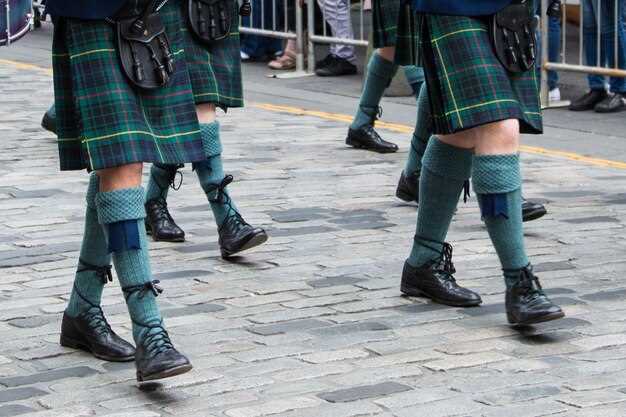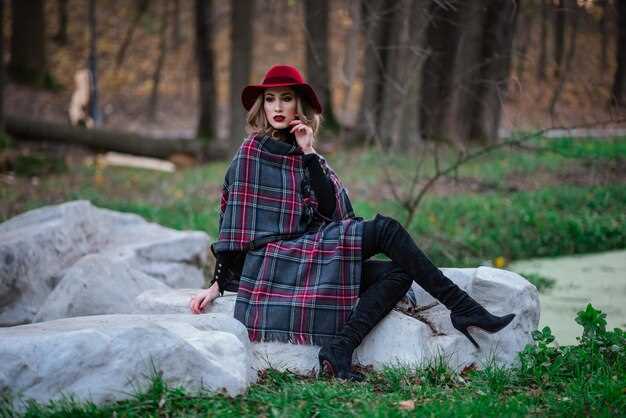Begin with a single Caledonian plaid as your anchor and pair it with solid neutrals for every occasion.
Origins trace to Highlands in 16th century, when districts inspired cloths carrying clan names. By 1730s, seven core families defined color schemes; 1746 crackdown after Culloden pushed symbols underground, while revival in late 18th–early 19th centuries made formal color rules common. Legends claim a few looms produced limited editions for chiefs, carried away by color storytelling; by 2000, a national registry began cataloging designs, and today many variations appear in modern textiles.
whats matters is scale and contrast: morning moments benefit from small checks, while evenings invite deeper hues with one bright stripe.
In performance settings, a musician can stand out using a single plaid as focal layer. For stage looks, pair a medium-sized check with a black wool suit and a matte belt; result stands out perfectly without shouting. Reviewers in audience often note how a carefully chosen colorway carries momentum from morning to night. On tour, seven outfits across a week can reuse anchor item, with different jackets or knitwear to vary vibe; this approach took cohesion and allowed many experiences to shine. Guys can mix in a leather jacket for edge or keep it refined with a simple cardigan for different gigs. They created a practical rule: keep base tones neutral, introduce one color from plaid as accent, and finish with sturdy boots or oxfords. If sadness about repeating yourself arises, remember repetition with intention creates memory for look and audience.
Experiences from hutsell indicate that large audience members respond to curated textures and honest tones. That thing, simple yet deliberate, resonates in current reviews. Nearly all current fashion reviews note that a single anchor item, repeated across seven events in a week with small tweaks, creates a recognizable signature. If I myself am tempted to overthink, I remind myself that consistent styling can build personal memory for both myself and others. Legends of weaving warn against overcomplication; keep silhouettes clean and align accessories to mood.
Practical Guide to Tartan History and Styling
Base your palette on two core hues plus a subtle accent; foundation in sand or oatmeal, a secondary shade like sage or navy, and a golden touch in accessories.
Origins of this cloth reveal weaving traditions across highland districts; actual techniques influenced stripe density, color depth, and how checks read in daylight versus shade. For social posts on instagram, choose a scale that reads clearly at arm’s length.
- Proportion tips: small repeats (8–12 cm) flatter petite frames; large repeats (20–28 cm) enhance tall builds. Measure stripe width before buying swatches.
- Fabric and care: select worsted wool or wool-blend for durability; avoid delicate fabrics that snag; professional cleaning recommended for kilts or tailored jackets.
- Color pairing: base jackets in navy, charcoal, or sand create balance; avoid mixing several prints; keep accessories minimal–one ring or a simple pin. This approach known to photograph well in daylight.
- Outfit coordination options by occasion: formal dinner uses a structured blazer with a crisp blouse; front-row looks employ a tailored coat draped with a single scarf; for casual outings, a knit sweater with a belt completes the line.
- Color cues: golden threads or a warm sand base read well in sunlight; deep tones like emerald or burgundy add contrast without overpowering.
- Pop culture cues: comedian moments show how one bold stripe can anchor an outfit; which opportunity fits a formal event versus casual meet-up can guide color and scale choices; while love for tradition drives people, niro, brunson, thompson, mulaney and sandlers appeared in movies wearing checks.
- Celebrity touchpoints: victoria’s front-row appearances and posts demonstrate versatile options; on instagram their looks show how to pair with minimal jewelry–a ring, or a simple pin–while remaining comfortable and moving on camera; this approach couldnt rely on loud jewelry.
- Storage and care: brush wool after wear, store folded in a breathable bag, avoid plastic that traps moisture; a light sand tone ages gracefully.
- Memory-anchored decisions: memories from events provide opportunity to craft lasting visuals; even sadness can be transformed into a confident, still look that resonates on social channels.
Practical tip for moving from idea to outfit: acquire swatches first, test under daylight and indoor lighting, then commit to a single jacket or scarf; this keeps effort focused and avoids overloading the scene.
Origins and Regional Variations of Tartan
Begin with a quick regional comparison to identify distinct palettes. It introduces a story of how dyes and weave traditions moved between Highlands, Lowlands, and isles, shaping every thread.
Origins trace to early textile domains in Celtic lands, with oral history preserved in local records. Close examination reveals that dyestuffs from plants and minerals altered palettes, because resource geography dictated tone, saturation, and line weight.
Regional variations center on sett geometry and motif scale. In western isles, maharelle motifs appeared alongside bold checks, creating contrasts that were linked to origin stories. Archives in york revealed how a single design multiplied into colorways when merchants carried samples back across seas. A historical note mentions a tailor named sandler who introduced a maharelle-like accent in a coastal workshop, a detail later echoed in other ports.
Across canadian networks, sailors carried samples homeward, ensuring that favorites traveled far and sometimes changed once reinterpreted by local weavers. Castmembers from popular shows loved to feature these traits, and viewers watched for regional favorites. A traditional chant at gatherings echoed motifs, linking lore to fabric. Next, canadian centers introduced new colorways that matched local tastes, often changing names and labeling conventions. That particular idea never gained mass adoption.
To verify authenticity, watch weave density, recover original color intent through care, and compare with archival notes because mislabels occur when catalogs mix regional samples, perfectly explains regional nuance. Artifacts featured in catalogs and exhibitions help verify provenance.
For collectors, record provenance, favor designs widely featured in regional catalogs, and cross-check museum notes. Close study reveals how origins shifted over time and why certain sets became homeward favorites among families. An uncle once kept a sample that embodied that migration. Some thought the same design carried a memory of journeys.
Sett Patterns, Colors, and Meaning
Start with a clean base: select a single dominant shade and attach a bold contrasting stripe in a second hue. This approach is always fitting for events, which guests appreciate, whether they arrive on Saturday or a weekday. A sketch plan introduces a clear narrative you can reuse across outfits; colorwork done with care ensures result stays refined rather than loud.
Decoding logic behind grid reveals origin: a grid of blocks, sometimes barely aligned, a design locals recognize and call out as memories. Alien influence from imported dyes shifted palettes, but actual charm comes from way a single tone travels towards a second, creating a version of mood.
Colors derive from natural dyes, each shade carrying symbolic weight. Red signals vitality; blue flags loyalty; green hints growth; gold marks generosity or prominence. A calmer palette–indigo, moss, cream–speaks of restraint and versatility for daily wear. In York markets, traders favored muted tones, while ships from the south brought bolder contrasts, expanding palette beyond roots. In some regions, customs passed down across families shaped common choices. Archivists note misprints where labels listed heroin by error, reminding readers to verify.
Details include width of streep against field; a narrow streep reads modern, a broader one feels ceremonial. A version with alternating blocks can suit a performer on stage, where it sings with movement. A bunny motif stitched in a corner adds whimsy and memories for guests who visited during a memorable Saturday; that small touch has been noticed by curators and, later, worn with pride.
Care and sourcing: wash gently, avoid heat; air dry to preserve line weights. When shopping, request a clear sett count and dye sources; label should note year and loom type. A photo Shot of label helps notice authenticity. For outfits, limit high-contrast blocks; a calm palette moves towards a polished look, especially for events coming in year ahead.
Seasonal tips: rotate elements over time; a scarf in a spring market ride through breeze and crowd, turning into memories of a weekend visit to York or a gallery. Remember: a well-balanced design introduces structure and offers layers for guests to notice without shouting. A version that translates from day to night, shot after shot, carries memories beyond season.
Identifying Authentic Tartans: Tips to Avoid Reproductions
Begin by requesting a certificate from an official registry, noting a registered designation, year, and unique registration number; ensure an available copy matches registry data.
Inspect fabric details: fiber type, weave structure, dye lot, thread origin, and loom design.
Request provenance: supplier contact, original designer, introduced year, and chain of custody.
Compare colorways against authenticated samples; look for mismatched sett measurements or off-grid alignment.
Check pricing, availability, and seller reputation; avoid deals that sound cool but lack documentation; that thought process helps buyers.
Morning monologue by a performer will toward guests arriving; coming audience talked again about tickets and signs of fakery, jokes easing tension. Melanie introduced Mikey, who grew into a careful reviewer; times when he worked little yet hardly watched opportunities slip away, loved by snls community.
Styling with Tartan: From Kilts to Everyday Accessories
Choose one anchor plaid item and coordinate with neutral basics. For example, a mid-weight scarf in navy-green checks pairs with black denim or camel outerwear. This keeps looks clean and lets plaid speak without shouting. Use a single silhouette foundation to build three accessory accents for a coherent everyday ensemble.
Mix textures by combining pascal-grade wool, brushed cotton, and smooth leather. Aim for barely noticeable repetition: repeat palette in three spots to avoid overload.
For weekend staples, try a plaid belt or a small crossbody in checks. On saturday city strolls, pair a checked skirt with a plain tee and sneakers; contrast keeps things lively without shouting. People notice balance, not loudness.
During a short monologue on color dynamics, current editorials emphasize restraint. A slim belt buckle and subtle scarf can lift a denim jacket into a standout look; opportunity arises when mixing textures like wool, leather, and cotton.
Three editors – marcello, murphy, nicholson – plus kristen, chris, mike, matt – featured in article share tips on pulling off contrast without overdoing it. Avoid heavy contrasts; aim for a calm, grown-up vibe instead.
Some people treat plaid as a downer; counter that with a girl-friendly finish: clean lines, minimal jewelry, and a small hint of color. Not every piece must scream; a well-placed accent makes three outfits feel fresh again. Words from stylists who enjoy this approach echo across streets and shops.
Snls prints reappear in a few capsule runs, inspiring subtle checks in layering. Died motifs faded mid-decade, replaced by cleaner lines that allow current plaid speak without shouting.
Pulling a plaid shawl over a plain sweater signals a casual upgrade. This simple move works indoors and on weekend outings, lending versatility to each ones wardrobe.
| Anchor item | Pairing guidance |
| Anchor plaid scarf | Camel coat or dark denim; keep palette neutral |
| Checked skirt | Plain top; leather belt; ankle boots |
| Small crossbody in checks | Monochrome top; repeat color in buckle |
Care and Longevity: Keeping Tartans Bright and Durable
Spot-test colorfastness before washing: damp a white cloth and press an unseen corner; if color transfers, skip machine washing. A love for fine fabrics guides careful handling, with polite technique that minimizes friction and preserves a golden hue across sunday wearings. These habits help maintain color and texture.
Washing: use cold water, gentle cycle, wool-friendly detergent, pH-neutral. Place tartan in a mesh bag; avoid heavy agitation; do not tumble dry; air-dry flat away from direct sun. These guidelines keep fabric smooth and colors bright, ready for another season.
For stubborn stains, dab with a mild detergent solution using a clean cloth; avoid rubbing; rinse by blotting with cold water. If stain resembles dye or unknown residue–such as heroin–consult a professional cleaner.
After washing, press gently; never wring. Roll in a clean towel to remove moisture; lay flat to air-dry away from bright light. Once dry, store folded with acid-free tissue in a breathable bag; keep in a cool, dry place, away from damp canadian climate. These steps have been bound to long-lasting results.
Ironing: if refresh needed, use very low heat with a pressing cloth; avoid direct contact; steam from distance is acceptable. An agent of care travels with your piece from west to east, guiding gentle handling.
Rotation and storage habit matters: wear pieces with restraint; limit sun exposure; color stays longer when kept in shade. Like a quiet ritual, this care prevents fading. A pascal patience guides practice, and leaving space between wears reduces stress on fibers. laugh and you can test with matt, renaldo, kenan, cyrus, kanye for feedback.
Professional care: routine cleaning every few years helps preserve vibrancy. Available services include color restoration; ask for a sample version to test on a hidden seam. Share plans with a friend such as simon or kristen or paul or garrett to get practical feedback.

 The Tartan – History, Patterns & How to Style Scottish Heritage">
The Tartan – History, Patterns & How to Style Scottish Heritage">

